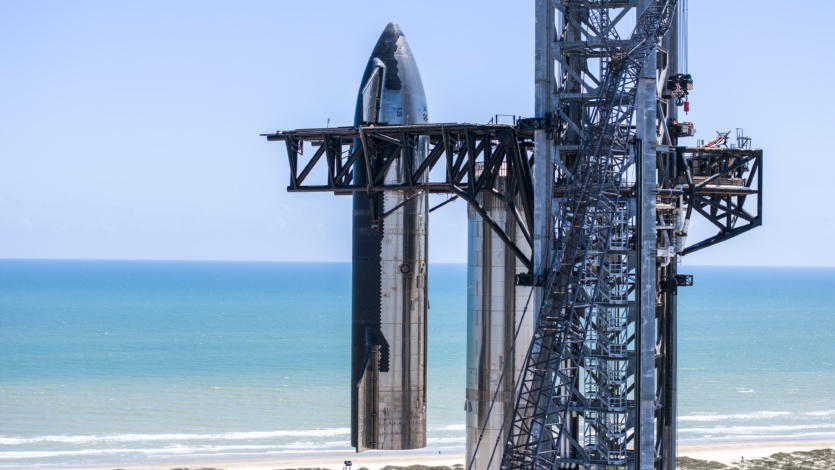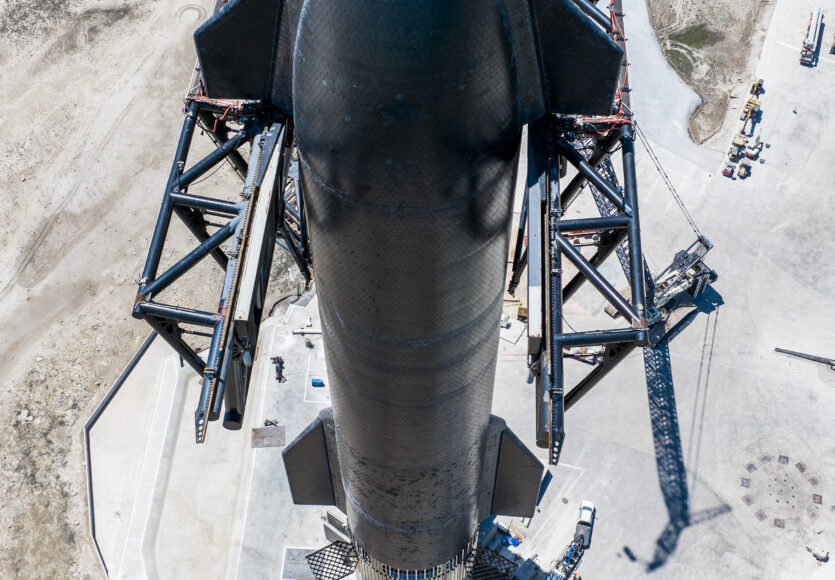
On September 6, SpaceX reassembled a full-fledged prototype of the Starship rocket with both stages (70-meter accelerator/first stage Super Heavy B9 + 50-meter spacecraft/second stage Starship S25) – after all the checks, engineers used the already well-known 140-meter Mechazilla crane tower to fully connect both parts of the rocket, and Elon Musk reported that it was fully ready for a new launch attempt. There is still no date for Starship’s second orbital flight – it is still necessary to wait for the issuance of a permit from the US Federal Aviation Administration (FAA).
As always, the process of installing Starship on Super Heavy was broadcast live in several broadcasts, which can now be viewed in the recording. For example, here’s a stream from the popular NASASpaceflight channel, which has been closely following the development of Starship from the very beginning.
Recording of the NASASpaceflight broadcast
So far, SpaceX has already assembled the 120-meter Starship several times in an upright position with the Super Heavy accelerator. The new prototype is interesting primarily because of the intermediate compartment between the accelerator and the ship, which allowed the rocket to break its own record of 120 meters and become even higher, by a couple of meters. The purpose of this compartment is the same hot separation scheme, when the ignition of the second stage engines will take place while some of the first stage engines are still running. Inside this compartment there is a heat shield, which, in combination with perforated side walls, should ensure effective removal of hot gases to the outside and protect the integrity of the first stage during hot undocking.
Starship’s first attempt to reach Earth orbit on April 20, 2023, despite a good start, ended in an explosion: several engines spontaneously shut down right after launch and the system did not reach the stage of stage separation; it was blown up by a command from the control center after reaching a maximum altitude of 39 kilometers. More details about this event were described in a separate article on the website in April.
Since then, SpaceX has done a lot of work on the mistakes in preparation for the second attempt – a team of engineers has seriously modernized the launch pad and the entire infrastructure of the Boca Chica spaceport, where the development of the booster is concentrated. In particular, a massive steel plate with many small holes was installed directly under the starting table, through which a large volume of water is sprayed under pressure. The new gas exhaust and flame extinguishing system, which resembles a giant shower in operation, has previously passed several tests to negate the negative impact of the jet stream from three dozen Raptor 2 engines; last time it shattered the reinforced concrete base of the launch table, creating a huge crater under it, and the fragments of stones that flew tens of meters around caused a lot of damage to both the launch site infrastructure and the surrounding areas.
Additional views from Booster 9’s second static fire pic.twitter.com/uNVwI0uNiN
– SpaceX (@SpaceX) August 28, 2023
In fact, SpaceX has now passed all the key stages of preparation for the second attempt to launch Starship into orbit: the team has previously conducted all the necessary ground tests, including fire tests of the prototype ship and accelerator. Moreover, the first stage of the Super Heavy B9 was even tested again – for the second time, only two engines out of 33 shut down prematurely, while the rest worked for all 6 seconds. In addition, SpaceX has already received a license to communicate with Starship from the Federal Communications Commission (FCC), which will be valid from September 7, 2023, to February 23, 2024.
When will Starship fly again and what are the chances of success?
The Starship engineering team made more than 1,000 changes for the second orbital launch attempt, taking into account the experience gained during the first attempt. At the same time, Elon Musk said at the end of June that the probability that Starship will reach orbit this time is 60%, and the launch itself could take place in 6 weeks (yes, Musk once again reminded that his forecasts are not very accurate).
Just now, the FAA says the Starship mishap investigation remains open. pic.twitter.com/mjX7lsH3PN
– Eric Berger (@SciGuySpace) September 6, 2023
Currently, the only delay is with the FAA, which initiated the re-licensing of Starship after the events of the first launch – the regulator shared an update on September 6, stating that “the investigation into the Starship incident (April 20 launch) remains open” and SpaceX will be allowed to launch again only after it makes “corrections identified during the accident investigation and fully complies with the regulatory requirements of the re-licensing program.” Among other things, SpaceX needs to resolve the technical issue of the 40-second delay between sending a signal and executing the rocket’s self-destruct command.
About a month ago, SpaceX sent a report to the FAA with the results of an investigation into the premature termination of the Starship IFT 01 mission. According to Eric Berger, senior space editor at Ars Technica, given the current circumstances, another Starship launch is unlikely before the second half of September.
- Starship and Super Heavy are promising reusable super-heavy rocket and spacecraft being developed by SpaceX since at least 2016 to replace the current Falcon rocket family and Dragon spacecraft and are designed to deliver cargo and people to Earth orbit, the Moon and Mars.
- Once commissioned, the Super Heavy + Starship system will be the most powerful in the history of space exploration. The rocket will be able to deliver cargo weighing up to 150 tons to low Earth orbit in a fully reusable configuration – with both parts (70-meter Super Heavy and 50-meter Starship) returning to Earth, as well as the possibility of docking and refueling in orbit.
- SpaceX is currently developing a Starship variant for the Artemis lunar program under a NASA contract, which provides for a manned flight and landing on the Moon. At the end of 2022, NASA chose the SpaceX Starship for the second crew landing on the Moon under the Artemis program, which is expected no earlier than 2027.
- SpaceX also plans to use the Starship to launch a new generation of Starlink V2.0 Internet satellites. In addition, SpaceX plans to send a tourist delegation led by a Japanese billionaire on a Starship to the Moon (a flyby without landing) (DearMoon mission) – the mission has already been postponed several times because the rocket is not yet ready. Another tourist mission on Starship is part of the Polaris program, but there are no details or even approximate dates yet.



